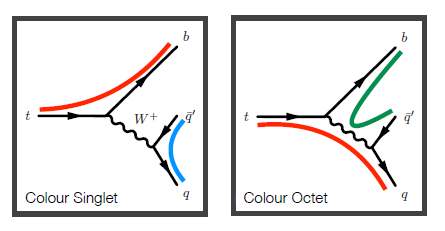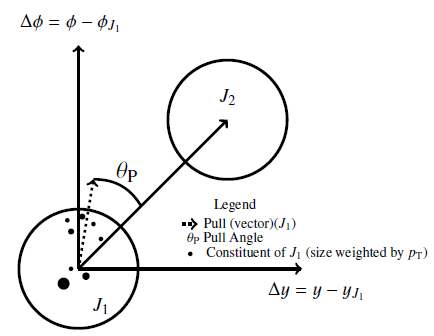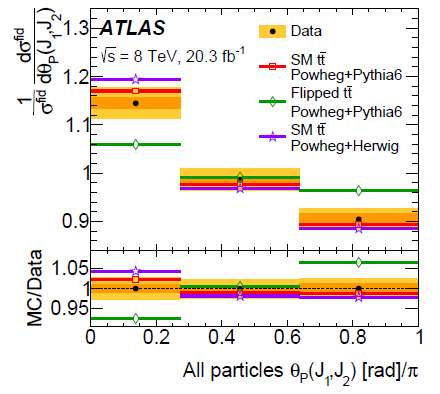Among them, one study which broke new ground was a search for the effect of colour coherence - a QCD phenomenon of interference in the colour field radiation off gluons and quarks. QCD was still being modeled quite incorrectly by Monte Carlo simulations, and that study, along with many others, provided the data on which more precise modeling of final state radiation was based.
For my study of top decays into hadronic jets, the modeling of QCD radiation was very important: in fact, among the few handles which could separate the top signal into six hadronic jets from the huge background of QCD processes there was the pattern of colour radiation. Jets emitted by W boson decays to quarks were expected to be narrower than jets originated from gluons -on this everybody agreed, although any suggestion of kinematic variables that would separate gluon from quark jets were highly frowned upon. But on the matter of the different flow of radiation between different jets there was not even a chance to convince anybody that you could construct a discriminating variable.
One person who studied the phenomenon was my colleague (once in CDF, now in CMS) Avi Yagil - he tried to find a signal of hadronic W bosons by vetoing jets containing hits in the vertex tracking chamber allegedly originated from "soft" radiation from QCD jets (those jets must be colour-connected to the hadron remnants from the collision). At some point he even thought he had seen a signal, but soon convinced himself that it was too big to be true. The study was soon abandoned.
Another one who started doing similar things was me - I was observing some different patterns of radiation in the data and in the simulation which could somehow be traced to those colour "strings". But I could not use those tools for the hadronic top observation, which we did publish in 1997. By then, I had started to apply the same ideas to the search of Z->bb decays, of which I did obtain a signal one year later (another "first" at a hadron collider).
 But those mentioned above were pioneering studies which were destined to have little or no follow-up in the short term. It was too early. The 1.8 TeV collisions of the Tevatron, and the glorious but imperfect CDF calorimeter, were not suited to capture the fine structure of jets and their subtle colour radiation patterns. Fast-forward 20 years, and here we are, with four times more energetic collisions, more data, and quite a far cry in detector capability. Using those atouts, ATLAS is now showing how a variable called "jet pull", which pictures the deformation of the "conical" shape of hadronic jets, can be used to discriminate the pattern of radiation coming from two quarks emitted from a colour-singlet W boson from that expected if the W boson were a coloured object. The two hypotheses are shown above, with the red, green, and cyan "strings" indicate where QCD predicts the maximum amount of final state radiation.
But those mentioned above were pioneering studies which were destined to have little or no follow-up in the short term. It was too early. The 1.8 TeV collisions of the Tevatron, and the glorious but imperfect CDF calorimeter, were not suited to capture the fine structure of jets and their subtle colour radiation patterns. Fast-forward 20 years, and here we are, with four times more energetic collisions, more data, and quite a far cry in detector capability. Using those atouts, ATLAS is now showing how a variable called "jet pull", which pictures the deformation of the "conical" shape of hadronic jets, can be used to discriminate the pattern of radiation coming from two quarks emitted from a colour-singlet W boson from that expected if the W boson were a coloured object. The two hypotheses are shown above, with the red, green, and cyan "strings" indicate where QCD predicts the maximum amount of final state radiation. The new ATLAS analysis has shown how W boson decays to quark jets in top events produce a different distribution of the jet pull variable if W bosons are colour singlets or octets. The jet pull is the angle between the direction along which a jet is deformed and the direction connecting the jet with a nearby partner. When the two jets come from the W, you expect that the colour string that extends between the two quarks originating the jets "fragments" into soft particles, which are in part clustered in the jets, determining the deformation and thus the angle. The picture on the left explains the matter graphically.
The new ATLAS analysis has shown how W boson decays to quark jets in top events produce a different distribution of the jet pull variable if W bosons are colour singlets or octets. The jet pull is the angle between the direction along which a jet is deformed and the direction connecting the jet with a nearby partner. When the two jets come from the W, you expect that the colour string that extends between the two quarks originating the jets "fragments" into soft particles, which are in part clustered in the jets, determining the deformation and thus the angle. The picture on the left explains the matter graphically.Below you can see how the data agrees with the colour-singlet hypothesis. The significance of the result is not to show that W bosons are colour singlets, of course -of that there is overwhelming evidence. What the analysis shows is that the variable can be used to study the pattern of colour radiation in the search for new particles.

The comparison of the data to the two different simulations (one based on Pythia6, the other on Herwig) is also interesting as it determines whether the models are capable of capturing these subtle features of final state QCD radiation. For more details, please read the ATLAS preprint.




Comments